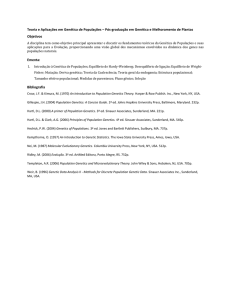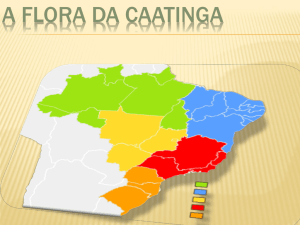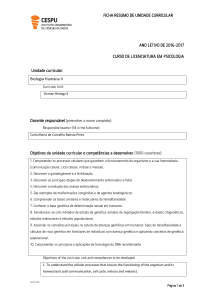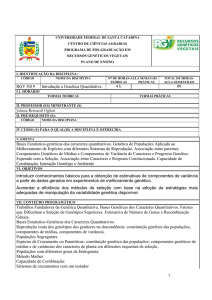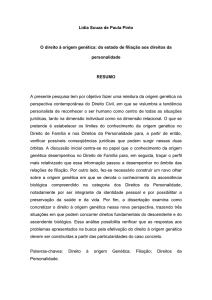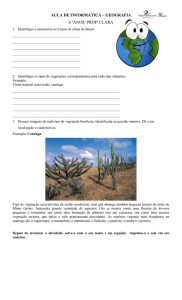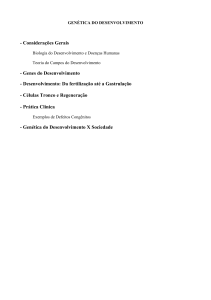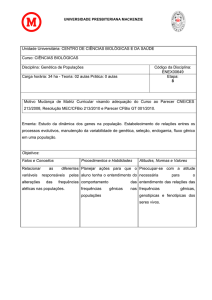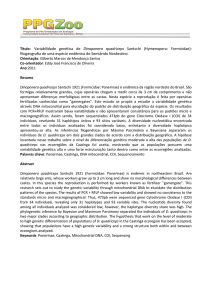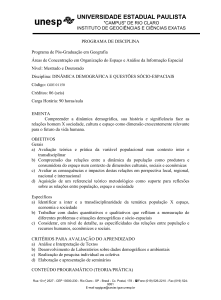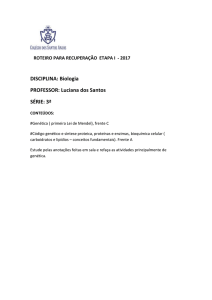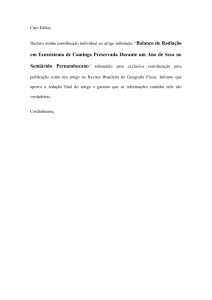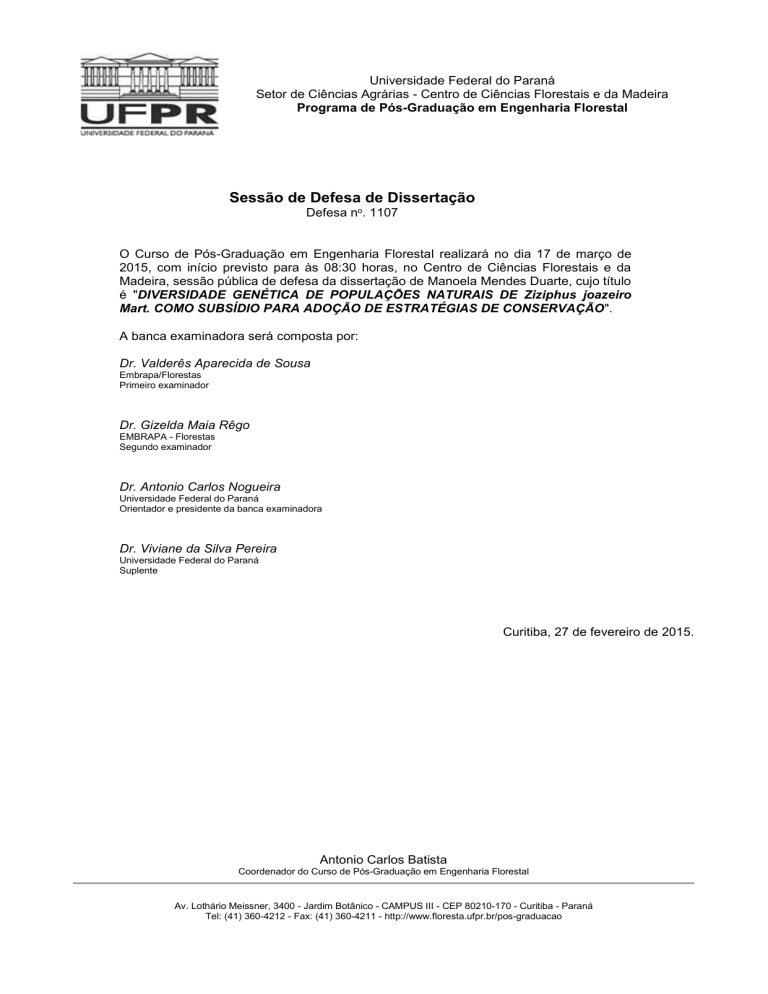
Universidade Federal do Paraná
Setor de Ciências Agrárias - Centro de Ciências Florestais e da Madeira
Programa de Pós-Graduação em Engenharia Florestal
Sessão de Defesa de Dissertação
Defesa no. 1107
O Curso de Pós-Graduação em Engenharia Florestal realizará no dia 17 de março de
2015, com início previsto para às 08:30 horas, no Centro de Ciências Florestais e da
Madeira, sessão pública de defesa da dissertação de Manoela Mendes Duarte, cujo título
é "DIVERSIDADE GENÉTICA DE POPULAÇÕES NATURAIS DE Ziziphus joazeiro
Mart. COMO SUBSÍDIO PARA ADOÇÃO DE ESTRATÉGIAS DE CONSERVAÇÃO".
A banca examinadora será composta por:
Dr. Valderês Aparecida de Sousa
Embrapa/Florestas
Primeiro examinador
Dr. Gizelda Maia Rêgo
EMBRAPA - Florestas
Segundo examinador
Dr. Antonio Carlos Nogueira
Universidade Federal do Paraná
Orientador e presidente da banca examinadora
Dr. Viviane da Silva Pereira
Universidade Federal do Paraná
Suplente
Curitiba, 27 de fevereiro de 2015.
Antonio Carlos Batista
Coordenador do Curso de Pós-Graduação em Engenharia Florestal
Av. Lothário Meissner, 3400 - Jardim Botânico - CAMPUS III - CEP 80210-170 - Curitiba - Paraná
Tel: (41) 360-4212 - Fax: (41) 360-4211 - http://www.floresta.ufpr.br/pos-graduacao
RESUMO: O bioma Caatinga vem sofrendo com o desmatamento acelerado, e em consequência disto, há uma redução
significativa de espécies. Ziziphus joazeiro Mart. é considerada espécie-chave na Caatinga, por se tratar de uma
essência nativa e de importância econômica e ecológica para a região do semiárido brasileiro. O objetivo deste trabalho
foi a caracterização da diversidade genética existente em populações naturais de Z. joazeiro com a utilização de
marcadores moleculares, para dar suporte às pesquisas realizadas no Projeto Bioma Caatinga. Doze ISSR marcadores
foram utilizados em 78 indivíduos, distribuídos em duas populações. O conjunto de marcadores gerou 220 locos
polimórficos para a população 1, e 74 locos para a população 2. Os resultados indicaram maior diversidade genética
entre os indivíduos da população 2. Para a população 1 heterozigosidade esperada (He) e o índice de Shannon (I) foram
de 0,13 e 0,25, respectivamente, e para a população 2, de 0,38 e 0,56, respectivamente. A AMOVA mostrou que a
maior parte da diversidade genética ocorre dentro das populações (59,69%). O fluxo alélico estimado foi considerado
baixo (Nm = 2,17). Não houve correlação significativa entre as distâncias genéticas e as distâncias geográficas
(população 1: r = -0,120 e p = 0,923; população 2: r = -0,21108 e p = 0,001). Não há estruturação espacial entre os
indivíduos da população 1 e 2 a partir das distâncias de 196 e 132 metros. Devido à variação genética observada, as
duas populações apresentam potencial para a coleta de sementes e formação de mudas a serem utilizadas em
programas de restauração de áreas e de conservação genética.
Palavras-chave: Bioma Caatinga. Juazeiro. Estrutura genética. Coleta de sementes. Recursos genéticos.
(Dissertação contendo 65 páginas).
GENETIC DIVERSITY OF NATURAL POPULATIONS OF Ziziphus joazeiro HOW ALLOWANCE FOR ADOPTION OF
CONSERVATION STRATEGIES
ABSTRACT: The Caatinga has suffered from the rapid deforestation, and in consequence, a significant reduction of
species, especially those that have economic potential. Ziziphus joazeiro is considered key species in the Caatinga,
because it is a native essence and ecological and economic importance to the Brazilian semiarid region. Therefore, the
objective of this study was to characterize the genetic diversity in natural populations of Z. joazeiro with the use of
molecular markers, to support research conducted by Project Caatinga Biome. Twelve ISSR primers were used in 78
trees-matrices, divided into two populations. The set of markers generated 220 polymorphic loci for population 1, and 74
loci for the population 2. The results showed greater genetic diversity between individuals of the population 2. For the
population 1 expected heterozygosity (He) and the Shannon index (I ) were 0,13 and 0,25, respectively, and the
population 2 of 0,38 and 0,56, respectively. The AMOVA most of the genetic diversity occurs within populations
(59,69%). The allelic flow estimated was considered low (Nm = 2,17). There was no significant correlation between
genetic distances and geographical distances (population 1: r = -0,120, p = 0,923; population 2: r = -0,21108, p = 0,001).
There was no spatial structure between individuals of the population 1 (Fij = -0,003; p = 0,253 and Fij = 0,023; p = 0,081,
first and second class away, respectively). In the population 2 was observed of individuals spatial structure for the first
distance class (Fij = 0,159; p = 0,003). Due to genetic variation observed, the two populations have potential, allowing the
use of individuals as trees matrix for seed collection purposes, restoration and genetic conservation programs.
Key-words: Caatinga. Natural populations. Genetic structure. Seed collection. Genetic resources.

